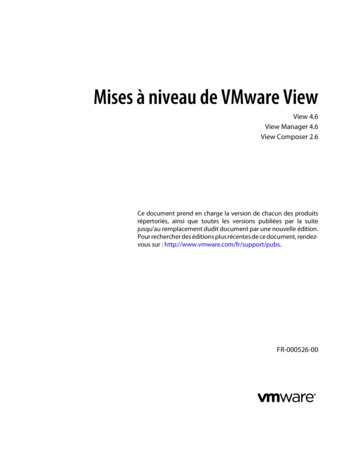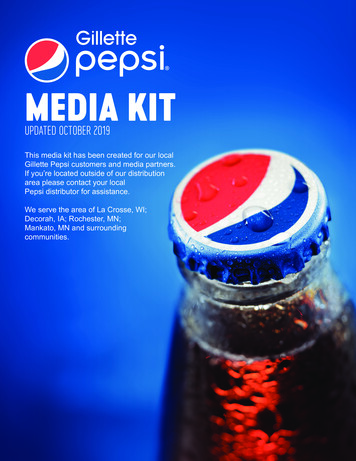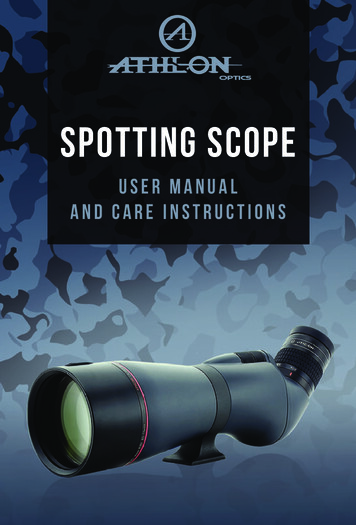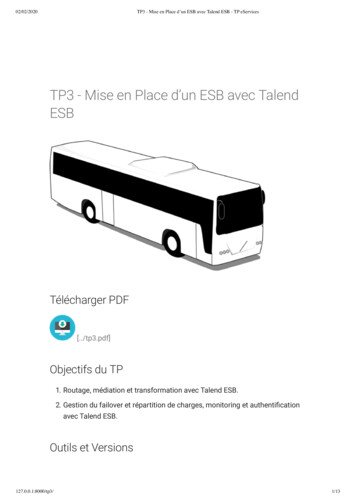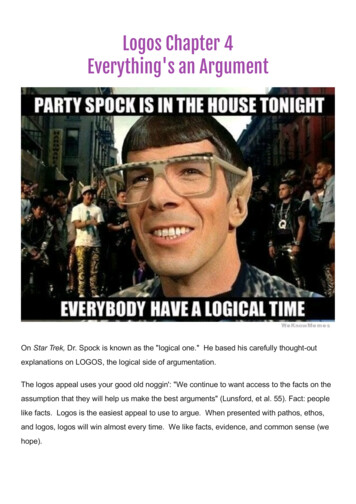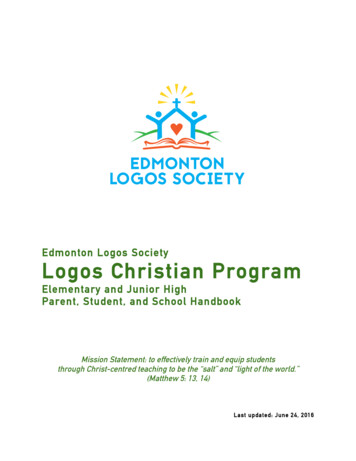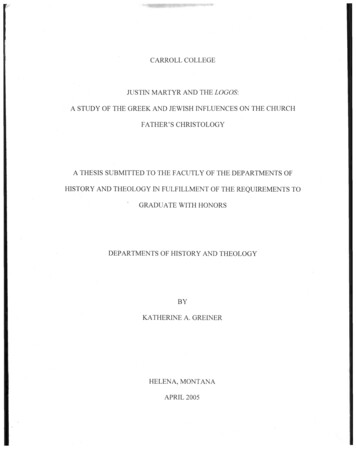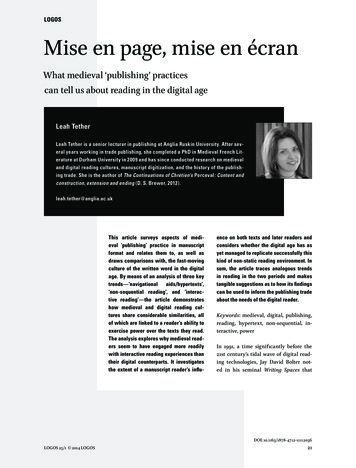
Transcription
LOGOSMise en page, mise en écranWhat medieval ‘publishing’ practicescan tell us about reading in the digital ageLeah TetherLeah Tether is a senior lecturer in publishing at Anglia Ruskin University. After several years working in trade publishing, she completed a PhD in Medieval French Literature at Durham University in 2009 and has since conducted research on medievaland digital reading cultures, manuscript digitization, and the history of the publishing trade. She is the author of The Continuations of Chrétien’s Perceval: Content andconstruction, extension and ending (D. S. Brewer, 2012).leah.tether@anglia.ac.ukThis article surveys aspects of medieval ‘publishing’ practice in manuscriptformat and relates them to, as well asdraws comparisons with, the fast-movingculture of the written word in the digitalage. By means of an analysis of three on-sequential reading’, and ‘interactive reading’—the article demonstrateshow medieval and digital reading cultures share considerable similarities, allof which are linked to a reader’s ability toexercise power over the texts they read.The analysis explores why medieval readers seem to have engaged more readilywith interactive reading experiences thantheir digital counterparts. It investigatesthe extent of a manuscript reader’s influ-ence on both texts and later readers andconsiders whether the digital age has asyet managed to replicate successfully thiskind of non-static reading environment. Insum, the article traces analogous trendsin reading in the two periods and makestangible suggestions as to how its findingscan be used to inform the publishing tradeabout the needs of the digital reader.Keywords: medieval, digital, publishing,reading, hypertext, non-sequential, interactive, powerIn 1991, a time significantly before the21st century’s tidal wave of digital reading technologies, Jay David Bolter noted in his seminal Writing Spaces thatDOI: 10.1163/1878-4712-11112036LOGOS 25/1 2014 LOGOS21
Leah Tether‘[Medieval manuscripts] presented a complex space ofwords, pictures, illustration, and ornamentation—themost complex prior to the electronic medium’ (Bolter,1991, p. 72). As such, he contests that ‘[o]nly in the medieval codex were words and pictures unified as they areon the computer screen’ (p. 74).Even at this early stage of development in digitalculture, Bolter had realized that new digital technologies had the potential to provide a reading experiencefar closer to that of the medieval manuscript than anyprinted book had ever been able to achieve. He therebyimplicitly suggests that there may exist a crucial—andperhaps surprising—link between the developmentsof medieval and digital reading cultures. He reiteratedthis in the extensively revised second edition of thesame book, printed 10 years later (Bolter, 2001, p. 66).This is perhaps unsurprising, given that throughoutthe 1990s and early 2000s tantalizing hints from scholars occur in many analyses of the changing nature ofreading cultures, suggesting that certain historicalreading developments could mirror those brought bythe digital age. For example, in 1991, when Bolter waspublishing the first edition of his monograph, RobertS. Sturges (1991, p. 223) stated, ‘With the printing press,we are on the threshold of the modern world; nothinglike the medieval experience of reading will reappearuntil the postmodern.’ As technology began to developat a rapid pace, so too did the argument. What beganas generalizations about the phenomenon came to besupported by examples of specific and tangible aspectsof reading practice which corresponded between medieval and digital cultures. For example, in a discussionof digital hypertexts six years later, Vincent Gillespie(1997, pp. 208–209) remarked thatThe texture and detail of a hypertextual experienceis largely in the control of the user. By analogy, thisseems to me to be similar to a medieval reader’sexperience of illuminated, illustrated and glossedmanuscripts containing different hierarchies of material that can be accessed in various ways.And just a few years later Jonas Carlquist (2004,p. 106) noted another similarity in his exploration ofmethods for imitating medieval reading experiences ina digital environment:22Mise en page, mise en écranIf medieval manuscripts—especially compositemanuscripts—were meant to be read in a multisequential order, digital technology might make itpossible to revive the different possibilities of reception structure in a way that paperbound editionscannot do.Despite these hints of there being a close link betweenmanuscript and digital reading cultures, and despitethe fact that the aim of these works was to explorereaders’ engagement with what was, at the time, a new,digital world, not one pursues the matter in the kind ofdetail one might expect—that is, as a means of showcasing medieval reading culture as a rich, untappedarea that offers a way of understanding a reader’s needsin the digital environment. The works largely revolvearound comparing the dissimilarities between printand digital, rather than exploring the similarities between manuscript and digital. Of course, at the timethese scholars were writing, the explosion of digitalhad yet to ignite, and it was not yet clear when, or evenif, the fuse would catch at all, which might explain thissomewhat cautious approach. After all, highlightinghow a format is so vitally distinct from that to which weare used is rather less encouraging than explaining theways in which we might find it to be familiar. It was,though, not long thereafter that Amazon announcedits release of what is usually considered the first ‘successful’ e-reading device—the Kindle (Amazon.com,2007)—and the imminent ‘death of the book’ began tobe even more widely predicted.1 In light of this, it is remarkable that scholars did not return to these insightsduring the resulting upsurge in, and success of, bothdigital content and various other e-reading devicesafter the watershed of 2007. Their silence is especiallystrange given the fact that these developments have effectively and efficiently coerced the publishing sectorinto increasingly adopting business models that aim tounderstand and target book consumers more directlythan ever before.2 As such, findings illuminating how adigital reader’s needs might evolve could provide trulycrucial drivers for future publishing developments.In this article, I intend to take a few tentative stepstowards redressing this imbalance. I shall, first, survey those trends of medieval reading and ‘publishing’3in a manuscript culture alluded to by Bolter, Sturges,LOGOS 25/1 2014 LOGOS
Leah TetherGillespie, and Carlquist and, second, relate them to thefast-moving culture of the written word in the digitalage. The trends in question will be encapsulated under three main headings: the uses of navigationalaids/‘medieval hypertexts’; episodic or non-sequentialreading; interactive reading environments.As an industry, publishing seems to have beenblindly participating in the furore of the future of thebook debate, the demise of both the book and the publisher being likely to carry on being prophesied untilsuch time as publishers can justify the value of one,the other, or both. 4 Meanwhile, traditional academicinstitutions have been discretely directing projectsabout the history of the book, aiming to understand inwhat ways the material text has evolved thus far,5 butoften refuse (at least in the UK) to consider the book’sfuture. This is ostensibly because, as Andrew Brown(at the time of writing, the International DevelopmentDirector at Cambridge University Press) explained in amasterclass in March 2012, ‘it is impossible to evidencewhat has not yet happened’ (Brown, 2012). Perhaps,though, understanding developments in book histories can, as Gillespie and Bolter in particular hint, beused to provide informed and new insights into bookfutures, especially in terms of the developing needs ofthe digital reader. The aim of this article is therefore todiscover whether traceable, analogous trends in reading between the two periods indeed exist and, if so,to what extent these trends can be used to inform thepublishing trade about the needs of the digital reader.The Uses of Navigational Aids/‘Medieval Hypertexts’As mentioned earlier, Vincent Gillespie (1997, pp. 208–209) noted the existence in manuscripts of what, tohis mind, constituted ‘medieval hypertexts’—that is,the presence of navigational aids that help the readerto move between different levels of information. Theterm ‘hypertext’ is drawn from computer terminology and refers to the notion of accessing, linking, andjumping between non-sequential information in a digital environment (Gillespie, 1997, p. 208, n. 10). In otherwords, these paratextual6 signposts provide readerswith markers that help them either (a) to navigate theirway through (or jump to sections of) a text or (b) tocross-refer easily between related materials. Applyingthis definition to manuscript culture, Gillespie (1997,LOGOS 25/1 2014 LOGOSMise en page, mise en écranp. 227) argues that rubrics,7 glosses8 and illumination9act as navigational aids in much the same way, exploiting hypertextual links between text and image. Whilst‘medieval hypertexts’ obviously cannot be ‘clickedon’ in the same manner as their digital counterparts,Gillespie makes a valid point. Rubrics, glosses, and illumination regularly serve the purpose of linking thereader paratextually to various pieces of extratextualmaterial which facilitate the reader’s undertaking whatI shall call ‘functions (a) and (b)’, as designated above.He does, however, neglect to mention that it may bethat these elements do not do so interchangeably.Rubrics, on the one hand, given their tendency tobe used mostly as headings or introductions, seem tobelong more to function (a)—as a traditional navigational or finding aid, helping the reader to identify keymoments in a text. Examples of such rubrics are pervasive in manuscripts, but a particularly useful example is provided by London, British Library, MS Harley4431—a codex containing the works of Christine dePizan, the production of which was supervised byChristine herself. Here rubrics are used as headings foreach tale, and these correspond directly to a contentslist in verse which appears on f. 2v.10 Glosses and illuminations, on the other hand, most frequently link noncontingent contextual information to the main bodytext, and thus seem to be more indicative of function(b), operating in a manner more like that of a digitalhypertext in the sense described by Gillespie.11 Bibles,for example, were among the most heavily glossed codices, scribes often adding clues and interpretations tothe margins of specific psalms or passages to guide thereader to the ‘right conclusion’ (in keeping with medieval methods of exegesis). Sometimes, they copied in existing collections of authoritative glosses, which werefrequently longer than the text being glossed. Amongthese is the famous Glossa Ordinaria, a kind of anthology of glosses combining various biblical interpretations of the Latin Church Fathers, which can be viewedaccompanying the text—in just one of many examples—in Cambridge, Houghton Library, MS Typ 204. 12Illuminations, meanwhile, are found in many medievalmanuscripts, but only extensively in secular manuscripts from around the turn of 13th century, this beingindicative of an increase in reading alone rather thanin performance settings. Examples of illumination are23
Leah Tethernaturally very varied, but a good demonstration of anillumination providing non-contingent contextualrichness to a main text can be found in London, BritishLibrary, MS Stowe 947. This manuscript contains the famous Roman de la Rose, which was begun by Guillaumede Lorris, who apparently died before completing it,and concluded by Jean de Meun. On f. 30v, where thechange of authorship occurs, there is an illuminationof the two writers side by side—one apparently passingthe writing baton to the other. Although the text makesno mention of the change of authorship at this point (itonly does so in the closing colophon), this illuminationserves to alert the reader that what comes next is thework of a separate author. 13Carlquist (2004, p. 105) concurs particularly with thenotion of rubrics providing function (a) in relation totheir practical application in helping a reader to navigate a manuscript. So, too, does Armando Petrucci (1995,p. 138), who argues in his study of writing and readingin medieval Italy that paratexts (including glosses, rubrics, and illuminations, as well as other marginal ‘jottings’) assist reader orientation. M. B. Parkes (1991, pp.52–53), meanwhile, notes the same phenomenon andremarks on the increasing use of such aids as book production developed, particularly of running titles andtables of contents. The use of these ‘function (a)’ navigational aids is surely not unfamiliar to a modern reader.Chapter headings, running heads, contents pages, andsubheadings in the printed medium serve precisely thesame purpose of orienting a reader’s journey through atext. What is perhaps more interesting is not so muchthe mere presence in manuscripts of these navigationalaids, but rather that to which Parkes alludes: their increasing frequency in manuscripts in the later MiddleAges, before which time books did not contain so manyvisual aids to help a reader to grasp the structure of atext (Bolter, 1991, p. 38). By the 13th century, as literacybecame gradually more widespread and oral culturewas increasingly accompanied by written culture, bookproduction processes, striving to cope with escalatingdemand, moved ever closer to standardization and,ultimately, the advent of the printing press (Parkes,1991, pp. 49–53). In other words, the burgeoning written medium, which had mostly been accessible only tohighly educated and/or wealthy people, was not only indemand, but was also demanding, particularly for ‘new24Mise en page, mise en écranreaders’, who needed help to find their way throughtexts as they developed the skills required for operatingin a new medium (Parkes, 1991, p. 49). In response, medieval book producers learnt techniques and developeddevices—such as these glosses, illuminations, and rubrics—by which to engage readers more effectively(Bolter, 1991, p. 68). These visual cues, of course, thenbecame standardized in the age of print. The Breviary,printed by the renowned publisher Nicolaus Jensenin Venice in 1478 (as present in Glasgow, UniversityLibrary, MS Sp Coll Hunterian Bf.1.18, especially ff. 1r,146v), provides a particularly fine set of examples of theincreasingly sophisticated nature of these paratexts inthe printed medium.14 Crucially, therefore, manuscriptculture identified the need for readers to receive moreguidance in finding their way through a written text,and the techniques associated with that guidance developed throughout the age of print into the now commonplace textual adjuncts that pervade modern bookculture. Commonplace, that is, until the beginnings ofthe digital age, when the carefully developed mise enpage (methods of page layout aimed to engage a reading public, often argued to be based on the so-called‘Golden Section’15) appears to have been forgotten astexts began to be rendered in digital formats.The digital reading revolution—the time when people started to read at length on computer screens—started in the 1980s, but only gathered steam in themid-1990s with the adoption of the web (Vandendorpe,2007, pp. 204–205). The first vision of a digital library,where texts of length (which had been published elsewhere in printed books) were available to read in digital environments, came in the form of Michael Hart’sProject Gutenberg in 1971 (http://www.gutenberg.org).Within just 33 years, Google had announced its intention to digitize 15 million books (Vandendorpe, 2007,p. 208). The pioneers, Hart and his contemporaries,adopted a scrollable page largely bereft of the usualnavigational aids, but readers often complained of difficulties in following electronic texts (Liu, 2005, p. 702).Vandendorpe (2007, p. 208) points out the scientificreason for this: much like in a real scroll, the position ofspecific sentences on the screen effectively shifts in theviewing window as you scroll through, there being fewmarkers to help the reader find their place. A reader’svisual memory of the text is thereby severely impaired,LOGOS 25/1 2014 LOGOS
Leah Tetherwhich makes both navigation and content assimilationof a document more difficult than when using a traditional codex. Further, just like the tricky rolling and rerolling of a real scroll, it is difficult to control the flow ofdigital text, particularly in large documents, where aninvoluntary judder of the hand while scrolling down aside-bar can quickly result in a loss of place, especiallywhen there are few visible markers to catch the eye(Vandendorpe, 2007, p. 208). This was not seen as a serious shortcoming at the outset, however, as the screenwas for many years a mere transitory space: most readers would print lengthy texts onto paper rather thanread them on the screen (Liu, 2005, p. 702). While this atleast solved the problem of scrolling, it did not remedythe lack of visual markers. just like the tricky rolling andrerolling of a real scroll, it is difficultto control the flow of digital text,particularly in large documents, wherean involuntary judder of the hand whilescrolling down a side-bar can quicklyresult in a loss of place.Progressively, as reading on screen seeped into practice, tools for viewing page breaks, margins, headers,and page numbers appeared on word processors; butit was the advent of Microsoft Word in the mid-1980swhich established a robust response to the reader’sneed for visual control over what they were reading.WYSIWYG (What You See Is What You Get)16 technologywas adopted by Microsoft precisely to allow users to interact more naturally with digital texts (Vandendorpe,2007, p, 208). Adobe’s PDF format advanced this further,enhancing navigation by giving the reader tabular controls over the text, in order to scroll through laterally(‘codex-like’) or vertically (‘scroll-like’) (Vandendorpe,2007, p. 209). PDF format proved so popular that when,in the late 1990s, portable e-readers began to be produced, the producers of the devices all created at leastLOGOS 25/1 2014 LOGOSMise en page, mise en écransemi-traditional page layouts for their electronic material. They appear to have finally understood that, without this, the reader’s ability to assimilate content wouldbe compromised, and thus their experience adverselyaffected (Mangen, 2008, pp. 405–406). That it shouldhave taken nearly thirty years to rediscover whatreaders had already learnt in the Middle Ages seemsperhaps surprising. It does, however, demonstrate apertinent example of a parallel development in medieval reading culture which might have moved practicesin digital reading culture forward more quickly if theconnection had been identified sooner.The form of navigational aid identified as servingfunction (b) (allowing readers to cross-refer betweenrelated materials) fulfils less of a mechanical and moreof an enrichment role than those providing function(a). As we saw, glosses and illumination, as well as otherscribal/marginal features in manuscripts, provide access to further information upon which the main bodytext is not contingent, but by which it is enhanced(Olson, 2003, p. 60). Crucially, these elements provide asimilar service to digital hypertexts in so far as they allow a reader access to—and control over—how muchor how little extratextual information they desire. AsGeorge Landow (2001, p. 105) suggests: ‘Hypertext provides an infinitely re-centerable system whose provisional point of focus depends on the reader.’ In otherwords, the reader of a manuscript exercised a level ofpower whereby they could choose the extent of contextualization they desired, and access that contextthrough the manuscript’s ‘medieval hypertexts’, whichled them either to information in the margins of themanuscript or to intertextual knowledge from otherwritten texts and/or oral culture (Coleman, 1996, p.31). Whereas glosses clearly belong to the first of thesetwo things, illuminations often gave rise to the second,and the Book of Isaiah in the Bible provides a pertinentexample of this. At the beginning of the text, many extant manuscripts—such as London, British Library, MSRoyal MS 17 E VII vol 2, f. 36v 17—include a historiatedinitial in which Isaiah is shown being martyred by being sawn in half. Isaiah’s martyrdom is not included inthe Book of Isaiah, or anywhere else in the Bible; rather,the image is an intertextual reference to the one of thePseudepigrapha, The Ascension of Isaiah, which wasprobably written in either the 1st or 2nd century AD.25
Leah TetherThe image is, though, a striking and recognizable symbol of Isaiah and alerts the reader to the commencement of his work. Bolter’s argument (1991, p. 72) thatilluminations function like computer icons, servingsimultaneously as text and picture, is pertinent here.Effectively, illuminations both replace and displace thetext, and blur the boundaries between the reader andthe writer. Landow suggests that this kind of devicecalls for an ‘active reader’ (Landow, 2001, p. 102), that is,a reader who is in control of their reading experience—one who perhaps even has the power to contribute toit because of the multiplicity inherent in a manuscriptculture. 18Reading, therefore, is often described as ‘intensive’in a manuscript culture (Birkerts, 1996, p. 71). That is,in relative terms, readers had few texts to read, andso read what texts there were in great detail, whichbrought about particularly accomplished intertextualknowledge and a strong command and influence overthe texts they read. The vast multiplication of bookswhich came in the age of print would change this forever. Information abundance led to reading extensivelyrather than intensively, readers reading more widelyand, consequently, skimming material (Vandendorpe,2007, p. 204). With so much information becoming evermore available, and the demand for it growing, thestandardization of print meant that, despite attemptsto have early printed books mimic the format of manuscripts, the inclusion of glosses and illumination inbooks began very gradually to wane. The increasinglyexpansive, multi-layered information available mustsimply have become difficult to fit within the marginsof folia. Further, as print gave rise to standardization,the ‘web of text and interpretation, tradition and innovation’ (Bolter, 1991, p. 39) once held comfortablywithin the covers of a manuscript became technologically more and more complicated to reconstruct in theprinted medium (Maharg, 2006, pp. 43–44). In essence,early print technology created a demand for information which was, ironically, technologically unsustainable. Early printed texts did try to maintain glosses andilluminations, as we saw with Jensen’s Breviary above,but ever-longer print runs and unreliable colour printing meant that colour decoration en masse becameunfeasible. The volume of extra information and pushfor standard texts meant also that glosses did not sur-26Mise en page, mise en écranvive in the print world for long. As Sven Birkerts (1996,p. 159) argues, in the printed medium the book functioned as an artefact; it was a testament, in other words,to a writer’s authority, and the extra explicatory matterprovided by someone other than the author graduallyslipped out of use. Of course, new technology meansthat modern printed books, as already mentioned,can include such items. However, the technologicalrequirement for early printed books to adopt cleaner,less cluttered layouts (simply because it was not possible to reproduce the complicated, colourful layoutsof manuscripts for longer print runs at speed) effecteda cultural shift in readers’ expectations and, thus, intheir practical reading skills. Even if a modern printedbook were to include extensive glosses and illuminations in the manner of those contained in manuscripts,the reader’s ability to decipher and decode them wouldbe significantly different from that of a medieval reader. It would be unusual to see, for example, a modernprinted text where the ‘gloss’ on each page was three orfour times the length of the main text, as was possiblein manuscripts, mainly because modern readers havenot had to develop the ability to manage such textualenvironments.Where print technology failed to facilitate the continuing use of such lengthy and extensive ‘hypertexts’,digital technology positively saw them reborn. Thephysical writing space no longer limited the amount ofextratextual material to which the main text could belinked; Bolter’s ‘web of text and interpretation’ was thusre-established in digital form. But, as we have seen, thereading public was no longer used to a method of reading which drew the reader away from a linear narrativeto non-sequential information; their ability to engagewith texts in this way was, and even now remains,under developed.19 Effectively, the cross-referencingand memory skills required for reading non-sequentially were dulled by the linearity of print (Birkerts,1996, p. 122). And rather than viewing interaction withthe episodic, non-sequential nature of hypertextuality as a skill or opportunity, some see it as a threat tosustained reading owing to the fragmentary nature ofthe hypertext (Liu, 2005, p. 701). Manuscript culture,however, proves that different forms of reading—and,in particular, non-sequential reading—do not mean anend to literacy. As Bolter (1991, p. 2) argues, ‘[w]hat willLOGOS 25/1 2014 LOGOS
Leah Tetherbe lost is not literacy itself, but the literacy of print, forelectronic technology offers us a new kind of book andnew ways to read and write’. These new ways may bringadvantages. As technology has progressed, digital reading environments have gradually moved beyond usinghypertexts in their traditional form;20 the overridingfunctionality of hypertexts in linking non-contingentinformation and providing navigational aids is, however, being preserved, albeit in new guises. Digital textsstill operate within a hypertextual framework, but it isa more covert one. Non-sequential reading skills are already showing signs of becoming less rudimentary; thisdevelopment may herald the arrival of a more sophisticated digital reader who, in having become acclimatized to the digital environment, has already developedsome of the nuanced textual interaction capabilitiesthat we have seen in medieval readers. With this inmind, I shall now explore the notion of non-sequentialreading more broadly.Episodic or Non-sequential ReadingIt is well known that medieval audiences often receivedtexts in a non-linear fashion, that is, episodically, withnon-contingent interludes and a non-sequential structure (Carlquist, 2004, p. 108). The modalities of performance arguably lie at the root of this trend in textualreception. As Ong (1982, p. 143) argues: ‘Oral culture hasno experience of a length, epic-size or novel-size climactic linear plot.’ The low literacy levels in the MiddleAges, coupled with the logistical impossibility of listening to an entire romance from beginning to end, if onlyfor the constraints of time, meant that audiences wouldattend readings or performances of short tales, or sections of longer tales (Eliot and Rose, 2009, p. 5). And, asthe products of oral culture made their way into writtenform, the nature of orality was still perceptible on thepage. Medieval texts, for example, are known to havebeen copied in discrete units. Chaucer’s CanterburyTales almost certainly circulated as autonomous talesor as groups of tales in separate booklets or quires forthe purposes of performance because the various components of the work are found bound in various ordersacross all of the early manuscripts (Coleman, 1996, p.199). A further example is provided by London, BritishLibrary, MS Additional 36614, which contains Chrétiende Troyes’ Perceval, one of its prequels, and two of itsLOGOS 25/1 2014 LOGOSMise en page, mise en écranContinuations. The manuscript demonstrates changesof hand and/or short quires at or around each of thetextual transitions, but no overt statements of a changeof authorship are included at these points (see f. 4c, line15; f. 10d, line 26; f. 87a, line 11 and f. 166b, line 10, respectively). From a modern reader’s perspective, each textseems to run seamlessly into the next. The mechanical indications of textual transition, though, provideevidence that medieval readers retained an awarenessof the narrative having been constructed by several authors. In other words, medieval reading culture reliedon the audience’s knowledge of an entire textual system which they had gleaned through developing highlytuned memory skills as a result of operating in an oralculture (Olson, 2003, p. 201).As suggested above, ‘hypertexts’ also have the effectof inducing a reader to receive a text non-sequentially, in that they distract a reader from the main bodytext and redirect them, via glosses or illuminations,to contextual information or intertextual references(Landow, 2001, p. 106). This also supports the idea alluded to in the same section that a reader in a manuscript culture is more active, and wields greater power,than in a print culture. This means that they have veryspecific skills that enable them to operate withoutthe need for textual linearity to serve as the mode ofcommunicating coherence. D. H. Green (1994, p. 297)plausibly suggests that there was even a kind of enjoyment for a medieval audience in being plunged in medias res such that they would have to piece together anon-sequentially received narrative. I have argued thesame elsewhere (Tether, 2012, p. 17–18) in relation to theContinuations of Perceval, which ce
cessful' e-reading device—the Kindle (Amazon.com, 2007)—and the imminent 'death of the book' began to be even more widely predicted.1 In light of this, it is re-markable that scholars did not return to these insights during the resulting upsurge in, and success of, both digital content and various other e-reading devices
